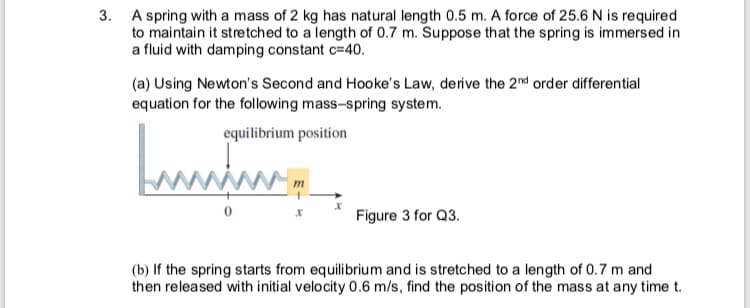A spring with a mass of 2 kg has natural length 0.5 m. A force of 25.6 N is required to maintain it stretched to a length of 0.7 m. Suppose that the spring is immersed in a fluid with damping constant c=40. (a) Using Newton's Second and Hooke's Law, derive the 2nd order differential equation for the following mass-spring system. equilibrium position Figure 3 for Q3. (b) If the spring starts from equilibrium and is stretched to a length of 0.7 m and then released with initial velocity 0.6 m/s, find the position of the mass at any time t.
A spring with a mass of 2 kg has natural length 0.5 m. A force of 25.6 N is required to maintain it stretched to a length of 0.7 m. Suppose that the spring is immersed in a fluid with damping constant c=40. (a) Using Newton's Second and Hooke's Law, derive the 2nd order differential equation for the following mass-spring system. equilibrium position Figure 3 for Q3. (b) If the spring starts from equilibrium and is stretched to a length of 0.7 m and then released with initial velocity 0.6 m/s, find the position of the mass at any time t.
Related questions
Question

Transcribed Image Text:A spring with a mass of 2 kg has natural length 0.5 m. A force of 25.6 N is required
to maintain it stretched to a length of 0.7 m. Suppose that the spring is immersed in
a fluid with damping constant c=40.
(a) Using Newton's Second and Hooke's Law, derive the 2nd order differential
equation for the following mass-spring system.
equilibrium position
Figure 3 for Q3.
(b) If the spring starts from equilibrium and is stretched to a length of 0.7 m and
then released with initial velocity 0.6 m/s, find the position of the mass at any time t.
Expert Solution
This question has been solved!
Explore an expertly crafted, step-by-step solution for a thorough understanding of key concepts.
This is a popular solution!
Trending now
This is a popular solution!
Step by step
Solved in 4 steps with 4 images
